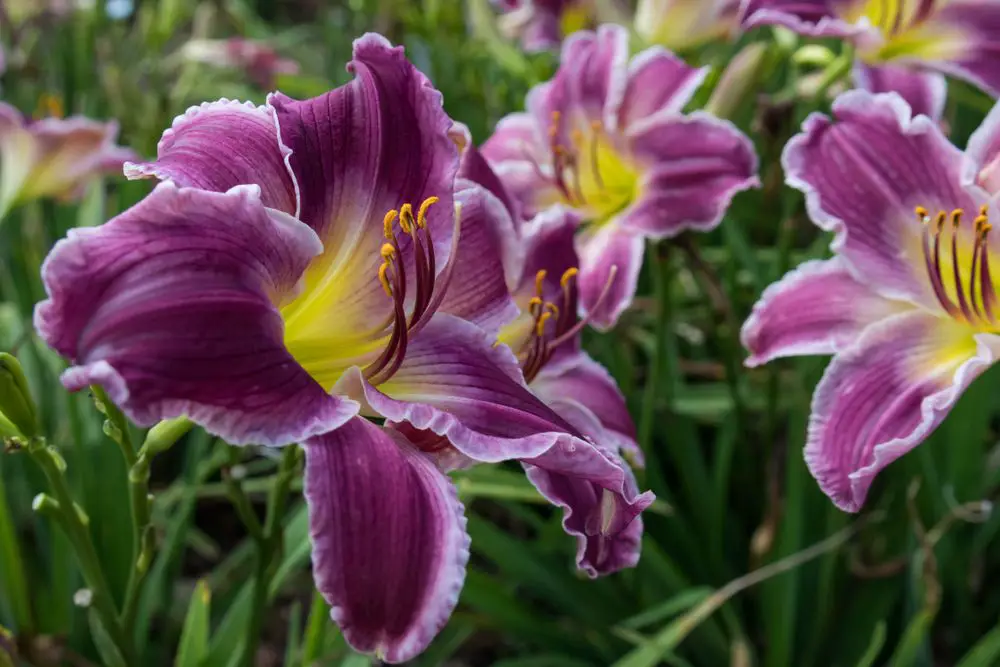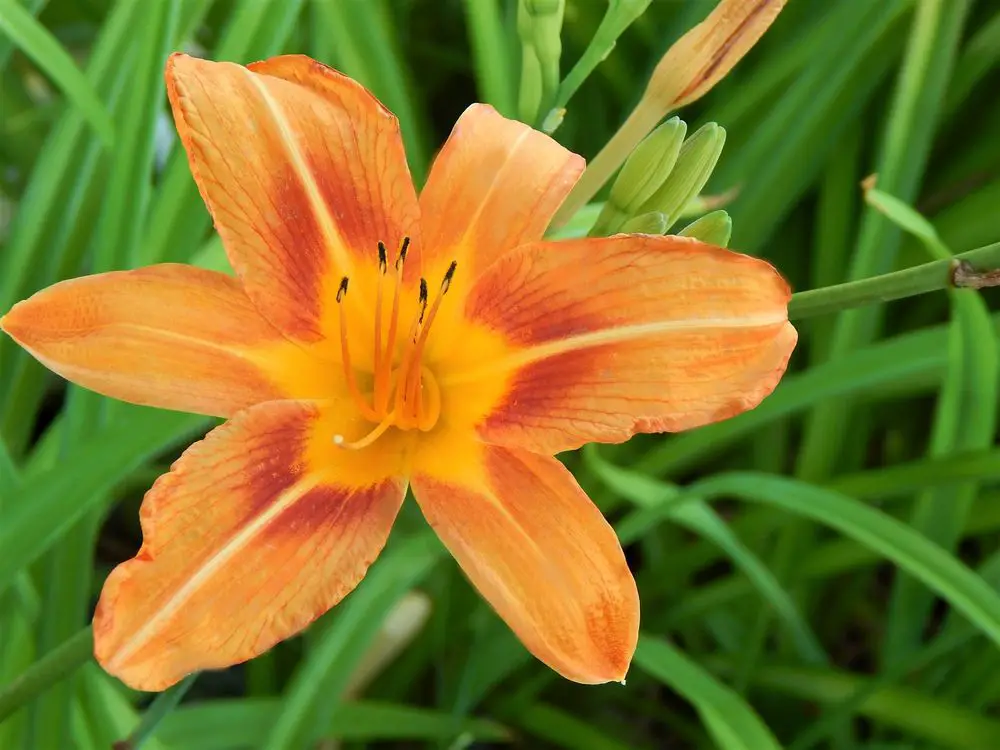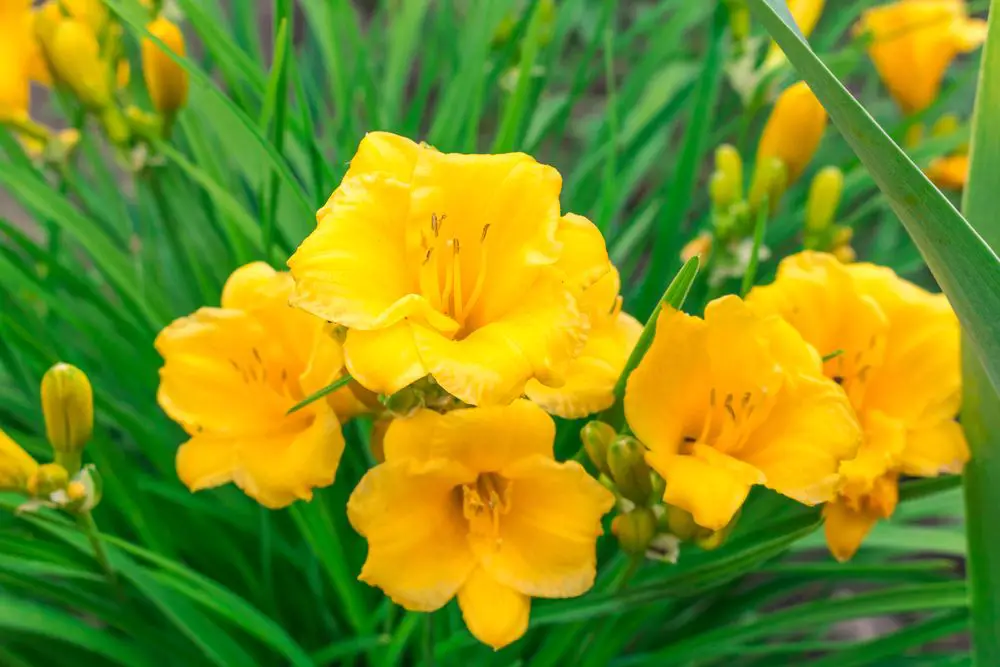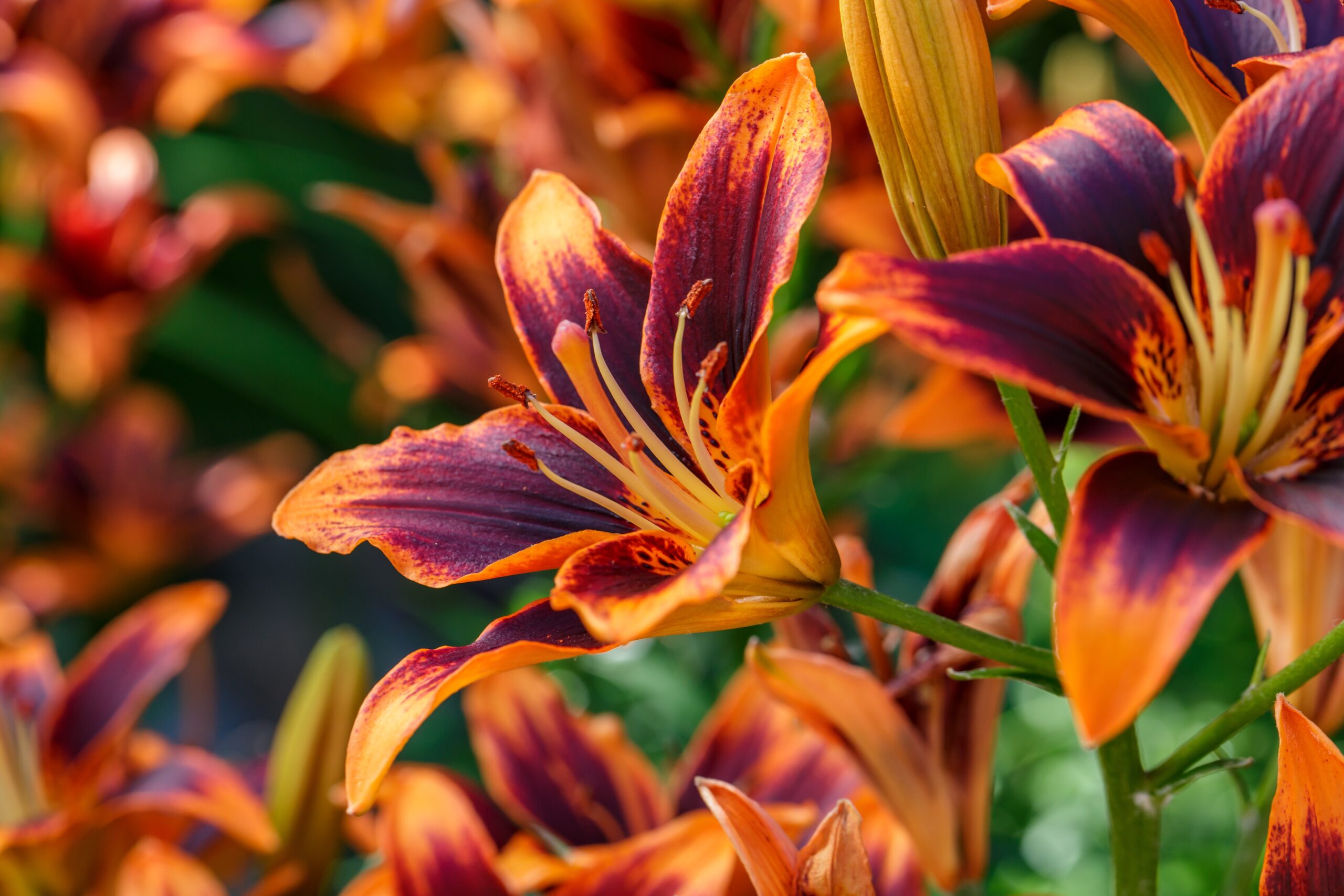Daylilies are perennial plants whose name references the fact that their flowers normally survive no more than 24 hours on the plant (about a day or so). In most species, the flowers bloom in the early morning hours and wither over the night, perhaps to be replaced by another flower on the same scape (flower stalk) the following day.
Daylilies have a huge range of colors – red, orange, yellow, white, pink, and purple – not to mention the bitones or bicolors. They’re also heat and drought resistance, and low maintenance, making them known as the perfect perennial – just some of the interesting facts about them.
Colors of Daylilies

Daylilies are available in an incredible variety of colors and designs. The most common colors are red, orange, yellow, white, pink, and purple. Self-flowers are a single uniform color. Blends are made up of two or more colors that blend into one another.
In addition to daylilies, other blooms with different-colored petals and sepals are known as bitone or bicolor daylilies.
Daylilies may also be banded with distinct hues, bordered with contrasting tints, or have streaks running down the center of each bloom, among other variations.
Some of them even have what is known as diamond dusting, which means that they glitter or glimmer when you look at them.
The 10 Interesting Facts About Daylily
1. The Perfection of Perennials
Daylilies are often referred to as the “perfect perennial” because of their numerous characteristics.
These include showy flowers, a wide array of vibrant colors, drought tolerance, heat stress immunity, the ability to grow in most hardiness zones, and low maintenance requirements. They are a remarkable and stunning addition to any garden!
2. It Represents Motherhood
The daylily is a flower that represents motherhood and is associated with the season of spring. This is especially true in China, where it signifies a mother’s devotion. Also, it might signify a filial attachment to his or her mother.
Based on the manner the day lily was referred to in Chinese culture, it may be used to convey a variety of additional messages.
3. About Its Flowers
In most species, the flowers bloom in the early morning hours and wither over the night, perhaps to be replaced by another flower on the same scape (flower stalk) the following day. Some species bloom at night, while others bloom throughout the day.
When it comes to formal flower arrangements, daylilies are not usually used as cut flowers. However, they do make excellent cut flowers in other situations since fresh flowers continue to develop on cut stems for several days.
4. About Its Leaves
Depending on their leaf tendency, which portrays their sensitivity to cold weather, the leaves of Daylily can be classified as inert, partly evergreen on evergreen, and partially evergreen on inert.
The ones with evergreen foliage retain their leaves on a steady basis throughout the year. Leaves of the lethargic variety are those that lose their life over the winter and emerge in the spring that follows them.
Daylilies grow in plant solidity zones three through nine of the United States Department of Agriculture’s Plant Solidity Zones Program.
Semi-evergreen varieties retain their leaves throughout the winter in milder climates; but, in colder climates, its foliage withers and dies. Although the leaves are similar in appearance to corn or grass leaf, their bending tendency distinguishes them from other plants.
5. Its Types of Blooming
Daylilies are also classified depending on the sort of blooming that they produce. A length of time between each flush of flowers is required by reblooming plants; hence, they may fall dormant for a few weeks before blooming again.
The name “everblooming daylily” refers to the fact that the flowers bloom constantly throughout the summer.
The flowers can be further subdivided based on when they bloom.
Daylilies are classified as extra early bloomers, which bloom in the early spring, early bloomers, which bloom later in the spring, early mid-season, mid-season — which in most climates means early summer — late mid-season, late, and very late.
They are also classified as early bloomers, which bloom later in the spring.
The last two flowers appear in the late summer or early autumn. Most categories are separated by barely one or two weeks. The exact timing of blooming is determined by the climate.
Daylilies that bloom in the late afternoon and remain open all night are classed as nocturnal, which means they bloom in the late afternoon and remain open all night.

6. It Has Different Shapes
Daylilies are available in a variety of sizes and forms. Some flowers have petals that are extremely broad and overlap each other. Circular daylilies are a kind of daylily that is occasionally referred to as such. The tips of certain others are curved rearward.
Some petals have wavy borders or are fashioned like bells, while others are rounded. Spider daylilies feature long, extremely narrow petals that resemble the legs of a spider, which gives them their name.
7. About Its Sizes
Daylilies can also be divided into groups based on the size and height of their flowers. Flowers that are smaller than 3 inches wide are produced by the tiniest daylilies, which grow to heights ranging from 6 to 24 inches.
Medium-sized daylilies grow between 2 and 3 feet tall, with blooms ranging in size from 3 to 4 1/2 inches in diameter. When fully grown, the biggest daylilies may reach heights of more than 3 feet and have blossoms that are more than 4 1/2 inches across.
8. About Its Roots
Daylilies’ durability is dependent on the form and strength of their underlying roots. Strong roots are found in stringy, bunching root frameworks, which help to save water and provide support to plants during periods of drought.
The roots of the Daylily can ensure the tolerance of plants in every situation, even when delayed dry circumstances hurt plant life and reduce the number of blossoms.
Their extensive root systems provide disintegration control by stabilizing the soil structure. The underlying roots of plants prevent dirt from being washed downhill even when the plants are dormant and growth at the top of the plant has ceased to be active.
9. Its Other Types
There are various types of daylilies that exist. Diploid daylilies are the most common kind. They are more delicate and graceful in appearance than tetraploid plants, and they produce more flowers per plant.
Tetraploid daylilies are daylilies that have two times the number of chromosomes as diploid daylilies due to selective breeding. Larger flowers, more intense colors, and stronger stems are the result of this technique.
10. It Has Varieties That Blooms All Summer
Even though each daylily flower only lasts a day, you may enjoy blossoms all summer long if you grow the proper kind.
Reblooming or everblooming varieties are repeat bloomers that produce multiple flushes of bloom in a short period, allowing the plants to remain in bloom from the beginning of summer to the beginning of the fall.
Some species bloom at night, while others bloom throughout the day. When it comes to formal flower arrangements, daylilies are not usually used as cut flowers.
However, they do make excellent cut flowers in other situations since fresh flowers continue to develop on cut stems for several days.
Most daylilies grow in clumps, with each clump having leaves, a crown, flowers, and roots on its own.
The tall, linear-lanceolate leaves are arranged in opposing fans, with the leaves arching inwards as they grow. The crown is a little white section of the plant that is between the leaves and the roots of the plant.
Some daylilies have little leafy “proliferations” that occur at nodes or in bracts along the scape of the plant.
When a proliferation is planted, it develops roots and is frequently a perfect clone of its parent plant. Many varieties of daylilies have thicker roots, which serve as food and water storage organs.
A regular, single daylily flower contains three petals and three sepals, which are commonly referred to as tepals, and each includes a midrib that is either the same basic color as the rest of the flower or a distinct hue.
Tepals that are more distal to the center of the flower, known as the neck, are generally a different hue than the petals that are more central to the flower.
In most cases, each flower has six stamens, each of which bears a two-lobed anther. A flower creates a botanical capsule after it has been successfully pollinated.
The Variety of Stella Daylilies

“Stella de Oro” is one of the most well-known reblooming daylilies, and it gives color from late spring to late October for gardeners (Hemerocallis x “Stella de Oro”).
This type produces 2-3/4-inch yellow-gold flowers and is hardy in USDA plant hardiness zones 4 through 11, according to the U.S. Department of Agriculture.
Hemerocallis “Blackeyed Stella” is a related variation, but its blooms have a dark red eye, whilst the “Blackeyed Stella” variety does not.
USDA zones 3 through 10 are suitable for growing this variety.
The Return Varieties
It is believed that the “Happy Returns” variety (Hemerocallis “Happy Returns”) is a descendant of the “Stella de Oro” variety.
In USDA zones 3 through 9, this everblooming daylily has lemon-yellow blooms that may reach 3 inches in width and are hardy in the shade.
Final Thoughts
If you’ve ever seen a bed full of these beautiful flowers, they look gorgeous and are replaced almost daily with new blooms. A profusion of colors requiring little or no maintenance. You’d want to start planting them straight away!
For any garden they are an absolute must have.
Jenny Marie
Tribal Writer
Edited By
Patricia Godwin

